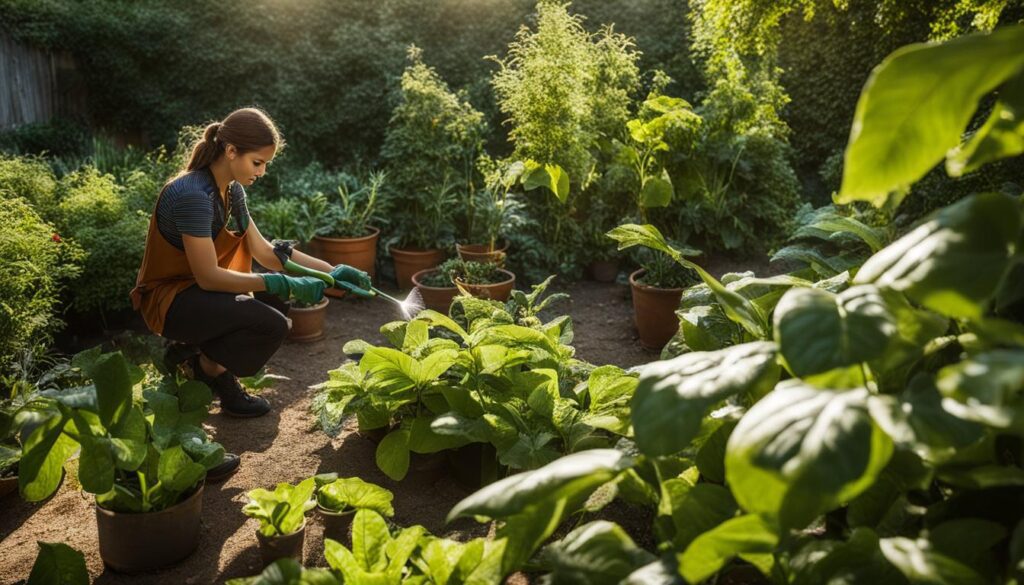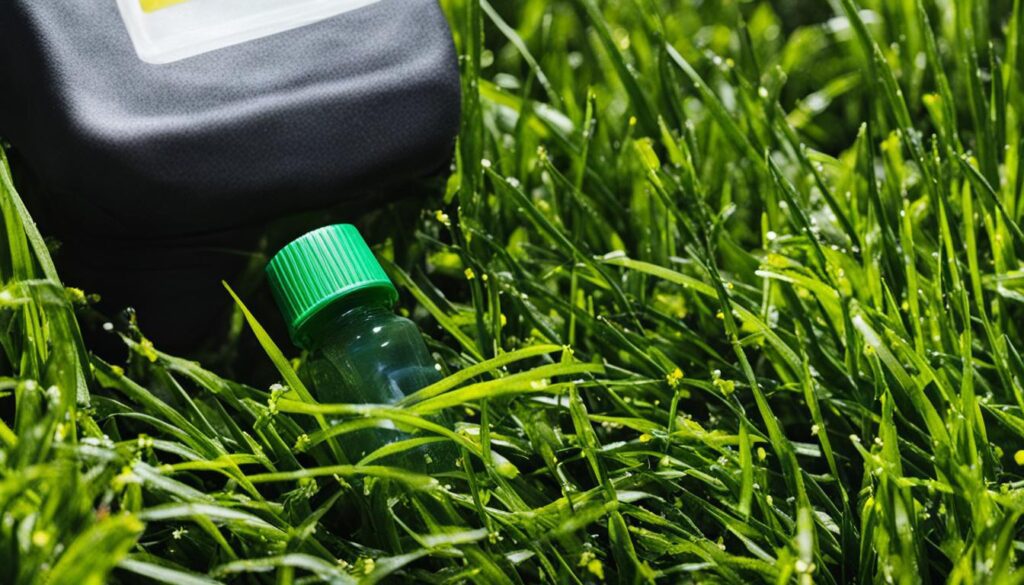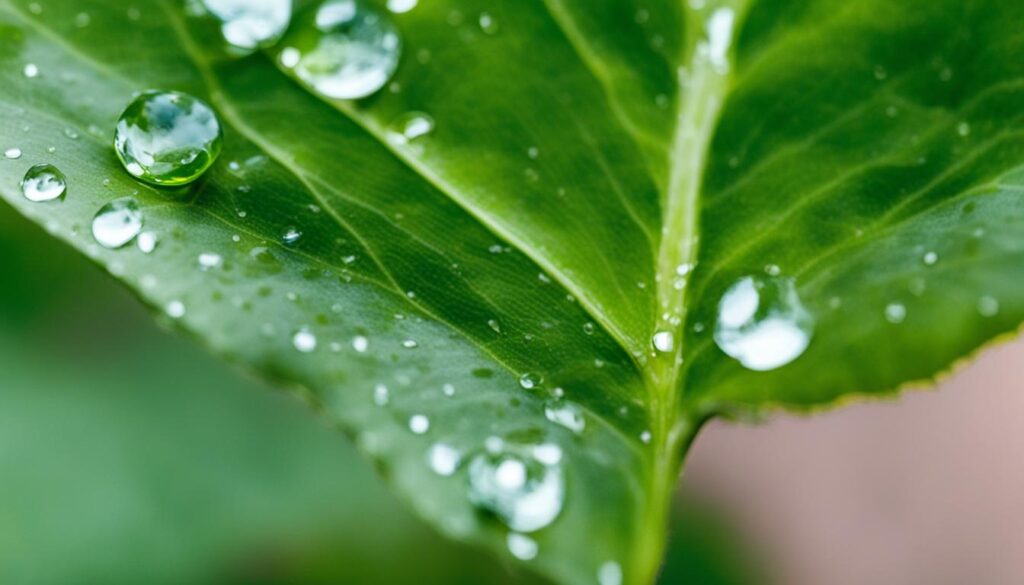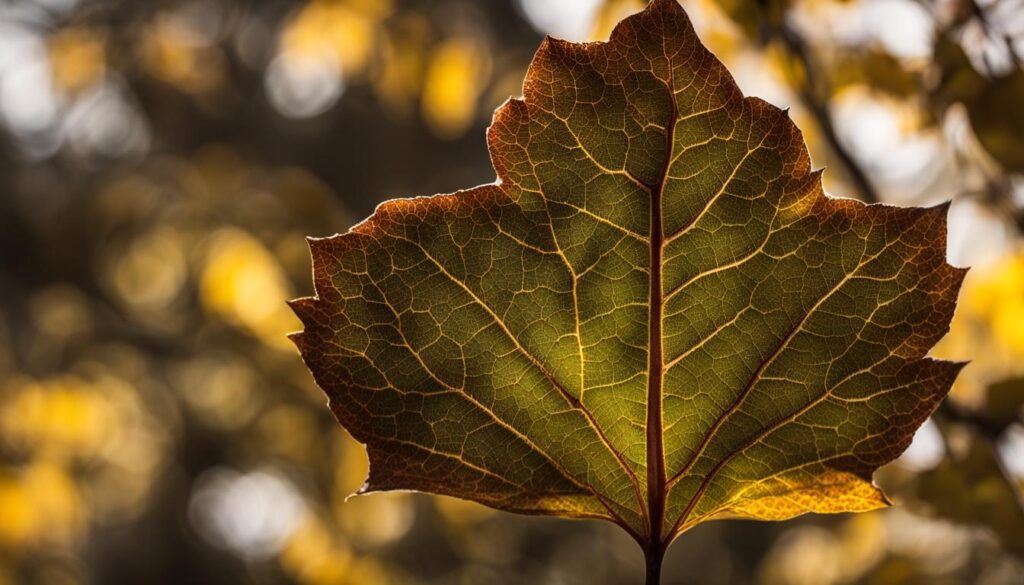Welcome to my article on effective leaf spot treatment solutions. Leaf spot diseases can be a persistent issue for trees and shrubs, impacting their health and vitality. If left untreated, leaf spot diseases can lead to significant leaf loss and weaken the overall structure of the plant. In this article, I will discuss various treatment methods and prevention strategies to help you combat leaf spot diseases and maintain a healthy garden.
Key Takeaways:
- Understanding the causes and symptoms of leaf spot diseases is crucial for effective treatment.
- Managing leaf spot diseases involves proper pruning, increasing air circulation, and avoiding overcrowding.
- Natural remedies, such as good watering practices and organic fungicides, can help control leaf spot diseases.
- Leaf spot diseases can also affect houseplants and lawns, requiring specific treatment approaches.
- Preventing leaf spot through proper care and maintenance is essential for long-term plant health.
Understanding Leaf Spot Diseases
Leaf spot diseases are a common issue that affects a small percentage of a tree’s overall leaf area. While they may seem concerning, leaf spot diseases are typically a minor stress on the health of the tree. These diseases manifest as spots on the leaves, which can occur on the upper, lower, or both surfaces.
The appearance of leaf spots can vary, with some being angular or rounded, and others raised or sunken. The edges of the spots may be smooth or fringed. Additionally, the color of leaf spots can range from yellow to yellow-green, orange-red, light tan, brown, or black. Each type of leaf spot disease is caused by a different pathogen.
Identifying leaf spot diseases is important for effective treatment and prevention. By understanding the causes of leaf spot and how to identify different fungal leaf spot diseases, you can take appropriate measures to manage and control these issues.
Managing Leaf Spot Diseases
When it comes to managing leaf spot diseases, there are several key strategies to keep in mind. By implementing these practices, you can effectively reduce leaf spot disease and maintain the overall health of your trees and shrubs.
To start, it is crucial to rake up and properly dispose of fallen leaves before the first snowfall. This helps eliminate potential sources of fungal spores that contribute to leaf spot disease. Additionally, pruning trees or shrubs helps increase light penetration and improve air circulation, creating a less favorable environment for disease development.
Avoiding overcrowding plants is another important consideration. Providing adequate spacing between plants allows for better air circulation, which can help inhibit the growth and spread of leaf spot pathogens. Alongside this, watering trees at the base and utilizing drip or soaker hoses instead of overhead irrigation can reduce wet conditions, which are conducive to leaf spot disease.
Maintaining proper soil moisture levels is also crucial in leaf spot management. By consistently monitoring and irrigating plants as needed, you can create an optimal moisture balance that promotes plant health while minimizing conditions that favor leaf spot development. Applying a layer of mulch around trees can further help retain moisture and regulate soil temperature.
It is important to note that fungicides are typically not necessary for managing leaf spot diseases. However, if a tree has experienced extensive leaf loss for several consecutive years, it may be necessary to consult with a professional arborist or horticulturist to determine if fungicide treatment is warranted.
By incorporating these practices into your leaf spot management routine, you can effectively reduce the impact of leaf spot diseases and maintain the health and beauty of your plants and trees for years to come.
Identifying and Inspecting Leaf Spot Diseases
When it comes to dealing with leaf spot diseases, proper identification and inspection are key. By learning to recognize the symptoms and signs of leaf spot, you can take appropriate action to control and prevent the spread of the disease.
Leaf spots often appear first on the lower and inner branches of trees. They can vary in size, shape, and color, ranging from small dots to larger irregular patches. Some leaf spots may have smooth edges, while others may be fringed.
Inspecting the affected leaves closely can provide valuable clues about the presence of leaf spot diseases. Look for distinct patterns, discoloration, or irregularities on the leaf surface. Some common symptoms include yellowing, browning, or necrotic areas on the leaves. Leaf spot may also cause premature leaf drop.
It is important to examine not only the leaves but also the bark for signs of cankers. Cankers are localized dead areas on the branches or trunk, characterized by sunken, discolored, or cracked bark. Identifying the specific pathogen causing the leaf spot disease is crucial for implementing the appropriate treatment and management strategies.
To help you visualize the symptoms of leaf spot, take a look at the image below:
Natural Remedies for Leaf Spot Treatment
When it comes to treating leaf spot diseases, there are natural remedies that can effectively control and manage the problem. These remedies are safe for the environment and can be easily implemented in your gardening routine. By utilizing these natural solutions, you can maintain the health and beauty of your plants without relying on harsh chemicals.
One of the first steps in treating leaf spot is to prune affected leaves. This helps remove the infected foliage and prevents the spread of the disease. Be sure to sanitize your pruning tools between cuts to avoid spreading the disease to healthy parts of the plant.
Providing good air circulation and sunlight to the plants is another important aspect of leaf spot treatment. This helps keep the foliage dry, creating an unfavorable environment for the growth of fungi. Trim or remove any nearby shrubs or trees that may be blocking sunlight or impeding air circulation.
Overhead watering should be avoided as it can create conditions that promote leaf spot diseases. Instead, water the plants at the base or use drip or soaker hoses to target the roots. This method of watering reduces moisture on the foliage, minimizing the risk of leaf spot.
Maintaining proper soil moisture levels is crucial in preventing leaf spot diseases. Ensure that the soil is well-drained and not overly saturated. Mulching around the plants helps retain moisture and regulate the soil temperature, creating a healthier growing environment.
In addition to these natural remedies, organic fungicides can be used to control leaf spot diseases. Neem oil, for example, has antifungal properties and can effectively combat leaf spot. Apply the fungicide according to the manufacturer’s instructions and continue treatment as needed.


By incorporating these natural remedies into your leaf spot treatment plan, you can effectively manage the disease and protect your plants. Remember to regularly monitor your plants for any signs of leaf spot and take prompt action to prevent its spread. With a little care and attention, your plants can thrive and remain healthy throughout the growing season.
Leaf Spot Treatment for Houseplants
Houseplants can also fall victim to leaf spot diseases, impacting their overall health and appearance. As a plant lover, it is essential to take timely action and implement effective treatment strategies to combat leaf spot on indoor plants.
First and foremost, inspect your houseplants regularly for any signs of leaf spot. Look for discolored spots or lesions on the leaves, which may appear as small, roundish blemishes. If you notice any affected leaves, promptly prune them to prevent the disease from spreading further.
Proper air circulation is crucial for controlling leaf spot on indoor plants. Ensure that your houseplants are not overcrowded and allow enough space between them. This facilitates better airflow around the leaves and minimizes the chances of moisture accumulation, which can contribute to the development of leaf spot diseases.
Overhead watering should be avoided as it increases humidity and moisture levels on the foliage, creating an ideal environment for leaf spot pathogens to thrive. Instead, water your houseplants at the base, directly into the soil, to keep the leaves dry. Alternatively, you can use a drip or soaker hose for watering, reducing the risk of leaf spot.
An additional step you can take to treat and prevent leaf spot on indoor plants is to utilize organic fungicides. These products are derived from natural sources and can effectively combat leaf spot diseases without harming your plants or the environment. Look for organic fungicides specifically designed for houseplants and follow the instructions provided.
Taking the time to implement these leaf spot treatment measures can help ensure the health and vitality of your precious indoor plants. Regular inspection, pruning affected leaves, providing adequate air circulation, avoiding overhead watering, and incorporating organic fungicides into your plant care routine are key steps for effectively managing leaf spot on houseplants.
Leaf Spot Treatment for Lawns
Leaf spot can also affect lawns, leading to brown spots and rotting grass. It is important to address leaf spot in lawns as it can rapidly spread and cause significant damage to the overall health and appearance of the turf. To effectively treat leaf spot on grass, applying a suitable fungicide at the initial stages of the disease is crucial. One recommended fungicide for leaf spot treatment in lawns is Patch Pro. It is important to follow the instructions provided by the manufacturer for proper application.
In addition to using fungicides, practicing proper lawn care maintenance is essential for preventing the reoccurrence of leaf spot. Regular mowing at the appropriate height helps to create a healthier and denser turf, reducing the risk of leaf spot development. Proper watering techniques, such as deep and infrequent watering, should be employed to avoid creating an environment favorable for fungal growth. Fertilizing the lawn with a balanced fertilizer and ensuring proper soil nutrient levels can also promote the overall health and resilience of the grass, making it less susceptible to leaf spot.
In conclusion, addressing leaf spot in lawns requires a proactive approach. By combining the use of suitable fungicides, such as Patch Pro, with proper lawn care practices, including regular mowing, appropriate watering, and fertilization, you can effectively treat leaf spot on grass and prevent its reoccurrence, ensuring a healthier and greener lawn.


Preventing Leaf Spot in Plants
To prevent leaf spot in plants, it is important to prioritize the health and well-being of your plants. Effective preventative measures can help ensure that your plants stay strong and vibrant. Here are some tips to prevent leaf spot and maintain plant health:
1. Provide Good Air Circulation
Adequate air circulation is crucial in preventing leaf spot diseases. Make sure to space out your plants to prevent overcrowding, as this can lead to increased humidity levels and create an ideal environment for the growth of fungal pathogens. Prune any branches or foliage that may be blocking airflow to ensure good ventilation.
2. Avoid Overhead Watering
Leaf spot diseases thrive in moist conditions, so it’s important to avoid overhead watering whenever possible. Instead, water your plants at the base to minimize leaf wetness. Consider using drip irrigation or a soaker hose to deliver water directly to the roots without wetting the leaves.
3. Regularly Apply Organic Fungicides
Organic fungicides can be a valuable tool in preventing leaf spot. These products can help protect your plants from fungal infections and control the spread of diseases. Regularly apply organic fungicides as a preventative measure, especially during periods of high humidity or when you notice early signs of leaf spot. Be sure to follow the instructions provided by the manufacturer for optimal results.
4. Maintain Proper Plant Care
Proper care practices can go a long way in preventing leaf spot diseases. Be diligent in watering your plants, making sure to provide adequate moisture without overwatering. Fertilize your plants regularly to ensure they receive essential nutrients for healthy growth. Additionally, practice effective pest control to prevent insect damage that can weaken plants and make them more susceptible to leaf spot.
By following these tips, you can significantly reduce the risk of leaf spot and keep your plants thriving. Remember that prevention is key when it comes to leaf spot diseases. Take proactive measures to create a healthy environment for your plants, and they will reward you with lush foliage and vibrant blooms.
Conclusion
In conclusion, effective treatment and prevention methods are crucial in managing leaf spot diseases that can weaken trees, shrubs, and houseplants. To combat leaf spot, I recommend pruning affected leaves to remove the infected areas and promote new, healthy growth. This should be accompanied by providing good air circulation around plants, which helps reduce moisture and prevents the spread of fungal spores.
Avoiding overhead watering is another important step, as it minimizes leaf wetness and creates an unfavorable environment for the growth and spread of leaf spot pathogens. Utilizing organic fungicides, such as neem oil, can also provide effective control over leaf spot diseases.
Regular inspection and maintenance of plants, lawns, and indoor foliage are essential for early detection of leaf spot issues. By promptly addressing any signs of leaf spot, you can prevent the disease from spreading and protect the overall health of your garden.
By following these recommended treatment methods and implementing preventative measures, you can effectively manage leaf spot diseases and maintain a thriving and beautiful garden.
FAQ
What is leaf spot?
Leaf spot is a common plant disease caused by various fungal pathogens that appear as spots on the leaves of trees, shrubs, and other plants.
How do I identify leaf spot diseases?
Leaf spot diseases can be identified by the presence of spots on the leaves, which can vary in size, shape, and color. The spots may have smooth or fringed edges and can be angular or rounded.
How serious are leaf spot diseases?
Leaf spot diseases can weaken plants by interrupting photosynthesis and causing leaf loss. They should be taken seriously if they result in moderate to complete leaf loss for multiple consecutive years.
What are the best treatments for leaf spot?
The best treatments for leaf spot include raking up and destroying fallen leaves, pruning affected branches, improving air circulation and sunlight exposure, avoiding overcrowding, and using organic fungicides if necessary.
Can I prevent leaf spot diseases?
Yes, you can prevent leaf spot diseases by providing good air circulation, avoiding overhead watering, spacing out plants to prevent overcrowding, and regularly applying organic fungicides as a preventative measure.
What are some natural remedies for leaf spot treatment?
Natural remedies for leaf spot treatment include pruning affected leaves, providing good air circulation and sunlight to plants, avoiding overhead watering, and maintaining proper soil moisture levels. Some organic fungicides, such as neem oil, can also be effective.
How can I treat leaf spot on houseplants?
To treat leaf spot on houseplants, prune affected leaves, provide good air circulation, avoid overhead watering, and use organic fungicides. Regular inspection and maintenance are important to control the disease.
What should I do if I have leaf spot in my lawn?
For leaf spot in lawns, apply a suitable fungicide at the initial stage of the disease and practice proper lawn care maintenance, such as regular mowing, watering, and fertilization, to prevent reoccurrence.
How can I prevent leaf spot in my plants?
To prevent leaf spot in plants, provide good air circulation, avoid overhead watering, space out plants to prevent overcrowding, and regularly apply organic fungicides as a preventative measure. Proper plant care and maintenance can also help reduce the risk of leaf spot diseases.



